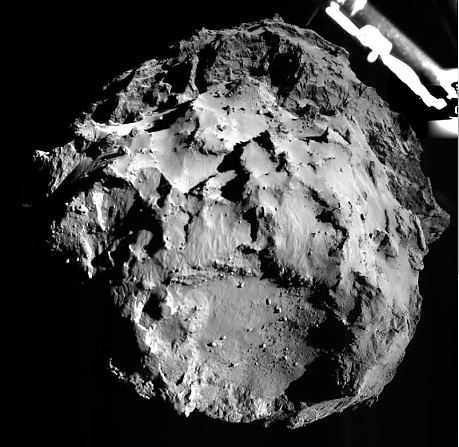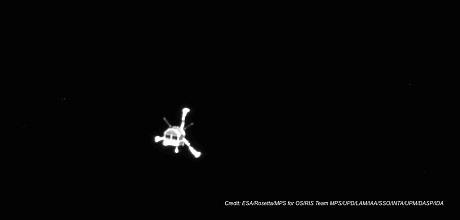November 12, 2014 – It is amazing what can be accomplished with robotic spacecraft. Rosetta, a project of the European Space Agency (ESA), and launched in 2004, is a Deep Space mission to Comet 67P/Churyumov-Gerasimenko. Rosetta has flown several billion kilometers on its epic voyage. In a deep sleep for 30 months Rosetta awakened in January of this year less than 10 million kilometers from the comet.
On board was Philae, an automatic-dishwasher-sized probe containing a package of scientific instruments and camera. If everything went right the probe was to separate from Rosetta and descend to the comet surface.
Today, that’s what happened. Philae left its Rosetta mother ship and at a walking pace drifted to the comet eventually landing on its surface. The image below, taken from Rosetta, shows the probe during descent.
Philae, equipped with harpoon anchors in its landing gear was supposed to fire them upon touchdown. But things haven’t exactly gone according to plan.
That’s because landing on a comet isn’t easy. Think about it. The target comet is small, a mere 4 kilometers (2.5 miles) in diameter. It’s currently traveling at speeds of 135,000 kilometers (almost 85,000 miles) per hour. It’s 673 million kilometers (420 million miles) from the Sun, and over 830 billion kilometers (520 million miles) from us here on Earth. And as it falls in closer to the Sun it is becoming active with jets of debris flying from its surface. Some of the ejecta has been captured in photographs by Rosetta.
Its gravity is infinitesimally small. That means for the lander to successfully touchdown it had to travel no faster than a slow walk. The firing of anchors could produce enough counteracting force to push Philae back into space. And right now with the anchors malfunctioning it appears that Philae’s hold on the surface of the comet is tenuous at best.
For the ESA team in charge of Rosetta, the suspense must be draining. At these distances it can take up to 50 minutes for Rosetta to transmit a signal to Earth. To manually override the on board systems on Philae there is a further delay because once the probe is on the surface communication can be lost as the comet rotates.
But Philae has landed, an amazing accomplishment. It should start sending us pictures and telemetry daily before its batteries drain. Philae is equipped with backup batteries and solar photovoltaics so it can recharge to provide power to the ten instruments on board. They will be used to study the comet’s composition and structure. A drill will sample the subsurface to a depth of 23 centimeters (approximately 9 inches). The on board spectrometer will analyze samples and tell us the comet’s chemical composition.
As the comet rotates it will be interesting to see how the transition from day to night will effect its stability and position on the comet’s surface.
During descent Philae gave us a treat, a close proximity picture of the landing area where it eventually touched down. The picture can be seen below with part of Philae visible on the upper right. Not since Huygens (also an ESA probe) descended to the surface of Titan from Cassini have we been treated to such exotic images. The landing spot is close to the centre in this picture. Below it you can see what appears to be a crater rim and plain dotted with house-sized boulders.
As for the mishap on landing, we will know the situation better when Rosetta and Philae resume contact. If we don’t here from Philae then the probe may have tipped over on the surface or suffered a malfunction. In any event the very fact that such a long distance maneuver could be achieved represents a significant technological accomplishment.
















